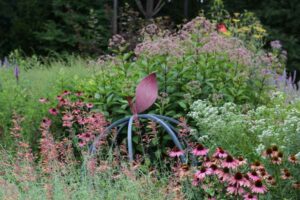From the Vine – Pollinators
go.ncsu.edu/readext?817084
en Español / em Português
El inglés es el idioma de control de esta página. En la medida en que haya algún conflicto entre la traducción al inglés y la traducción, el inglés prevalece.
Al hacer clic en el enlace de traducción se activa un servicio de traducción gratuito para convertir la página al español. Al igual que con cualquier traducción por Internet, la conversión no es sensible al contexto y puede que no traduzca el texto en su significado original. NC State Extension no garantiza la exactitud del texto traducido. Por favor, tenga en cuenta que algunas aplicaciones y/o servicios pueden no funcionar como se espera cuando se traducen.
Português
Inglês é o idioma de controle desta página. Na medida que haja algum conflito entre o texto original em Inglês e a tradução, o Inglês prevalece.
Ao clicar no link de tradução, um serviço gratuito de tradução será ativado para converter a página para o Português. Como em qualquer tradução pela internet, a conversão não é sensivel ao contexto e pode não ocorrer a tradução para o significado orginal. O serviço de Extensão da Carolina do Norte (NC State Extension) não garante a exatidão do texto traduzido. Por favor, observe que algumas funções ou serviços podem não funcionar como esperado após a tradução.
English
English is the controlling language of this page. To the extent there is any conflict between the English text and the translation, English controls.
Clicking on the translation link activates a free translation service to convert the page to Spanish. As with any Internet translation, the conversion is not context-sensitive and may not translate the text to its original meaning. NC State Extension does not guarantee the accuracy of the translated text. Please note that some applications and/or services may not function as expected when translated.
Collapse ▲I like to eat. I’m sure many of you reading this article likes to eat also, which is something we have in common. I have heard there are two philosophies on eating: some people live to eat, and others eat to live. I’m one of those that live to eat, planning my day according to which restaurant I will be closest to at lunch. My nephews eat to live. They must be made to sit down and only nibble at their food before they ask to be excused from the table. No matter which philosophy describes your eating habits one thing is true for all; without pollinators, we don’t eat.
Pollinators are responsible for one out of every three bites of food we eat. Pollinators include over 500 species of bees, 175 species of butterflies, the ruby-throated hummingbird, and thousands of insects that move pollen from flower to flower which results in fruit or seeds being formed in plants. Many of the fruits and vegetables we enjoy wouldn’t be available if pollinators disappeared from our planet. A small list of foods that would disappear includes apples, almonds, bananas, blueberries, citrus, chocolate, coconut, fig, grapes, peaches, pears, broccoli, cucumbers, melons, strawberry, sugarcane, tea, tomato, onions, squash, and vanilla. Crops that would disappear include hay, cotton, peas, peanuts, soybeans, beets, and sunflowers. Feedstocks that feed our beef, pork, chicken, and dairy industries would decline which would result in shortages in all these products. The take-home message to those that like to eat is to protect pollinators and enhance their natural environment to ensure there isn’t a breakdown in our food chain.
According to the USDA, during the past 20 years, the pollinator populations have suffered serious losses due to invasive pests and disease, exposure to pesticides, loss of habitat, loss of plant species and diversity, and changing climate. Our County Advisory Committee and Master Gardener℠ volunteers are concerned with these statistics that could impact our food supply. We are currently working on programming efforts to address this situation before negative impacts are felt by the consumer.
For the farmer, homeowner, local municipality, business owner, or landowner there are things you can do to help protect our pollinators. The biggest impact you can make is to enhance the habitat of pollinators by creating a pollinator garden or native pollinator landscape. To create a pollinator garden, select a site that has full or part sun with access to water. Take a soil sample and amend your soil according to the analysis. Plant native pollinator plants after the last threat of frost in the spring. Pick plants that bloom in the spring, summer, and fall of the year to help feed pollinators all year long. Some plants include purple coneflower, wild indigo, golden alexander, milkweeds, brown or black eyed Susan, lobelia, blazing star, buttonbush, asters, joe-pye weed, and goldenrod. Weed and water as needed and watch the pollinators move into your landscape.
For more information on pollinators, pollinator plants, or how to plant a pollinator garden, give the Master Gardener℠ volunteers of Sampson County a call at the Plant Clinic, 910 592 7161. You can also visit their vendor booth at the Clinton Square Fair, October 9, 2021, on Lisbon Street, or at the Sampson County Ag Day Event, October 30 at the Sampson County Expo Center.




